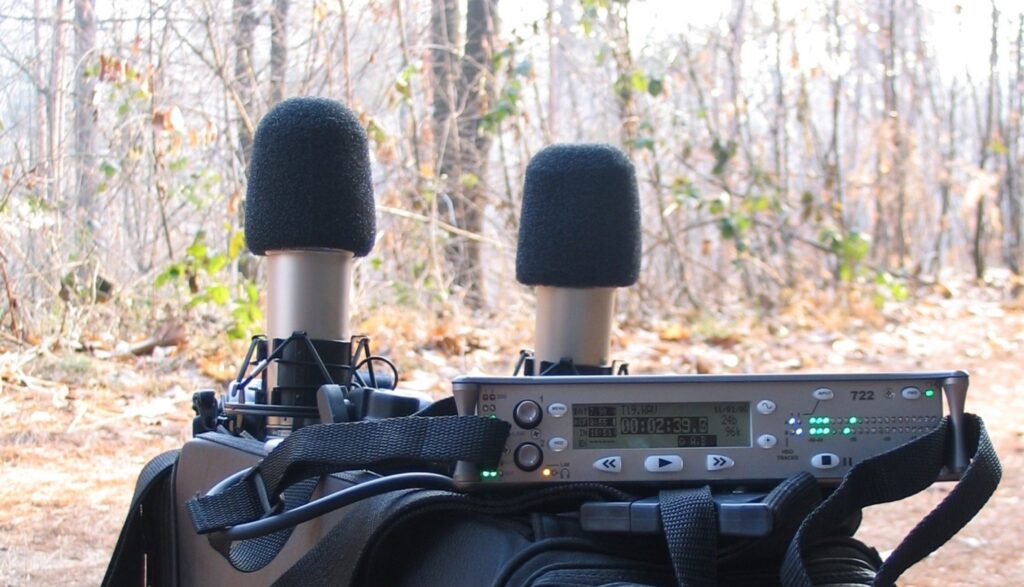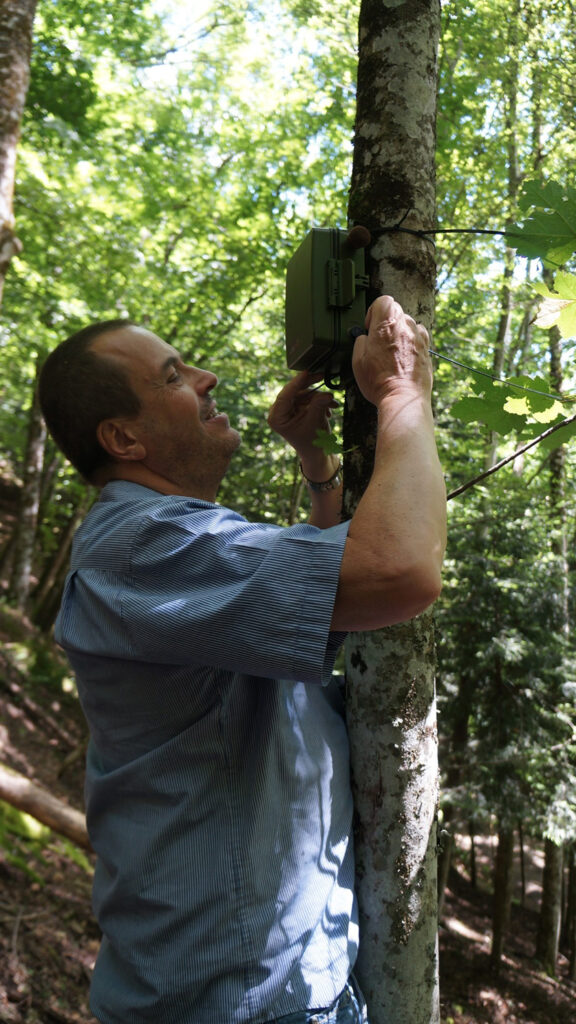GIANNI PAVAN
Reading Time: 10 minutesItalian version

Gianni Pavan – at work with a Telinga Stereo parabolic microphone.
Gianni Pavan, nato a Pavia nel 1960, si occupa di acustica e di suoni degli animali dalla laurea in scienze naturali con una tesi sull’analisi computerizzata del canto degli uccelli. Pioniere in Italia e in Europa della “computational bioacoustics” ha dedicato la sua carriera universitaria alla bioacustica e all’ecologia, partecipando alla fondazione di una nuova disciplina, l’ecoacustica, che coniuga bioacustica e ecologia. Dopo la laurea per molti anni si è dedicato allo studio dei mammiferi marini con lo sviluppo di strumenti e di software dedicati. Negli ultimi 20 anni si è sempre più dedicato allo studio dei paesaggi sonori, o meglio dell’ambiente acustico, comprendendo infrasuoni e ultrasuoni.
Oggi facciamo due chiacchiere con lui per conoscerne l’attività in campo bioacustico
Gianni, ci racconti come hai iniziato?
Ho iniziato con la passione per la musica, soprattutto classica, e per i suoni in generale, poi per la registrazione, poi ancora come “tecnico del suono” con una band di amici, e poi con i primi viaggi importanti negli anni ’70-‘80 la scoperta dei paesaggi sonori, ma non avevo strumenti adeguati. Da qui l’interesse anche per l’elettronica e il grande dubbio se fare Ingegneria Elettronica e l’allora nascente Informatica oppure Scienze Naturali. Poi con l’Università e la scelta di Scienze Naturali ho avuto modo di coniugare tutto in una unica passione, che poi è diventata una carriera di ricerca e di insegnamento: la bioacustica.
Più di recente?
Sono rimasto sostanzialmente fedele alle scelte iniziali, lo studio della natura con nuovi strumenti e nuove visioni, cercando appunto di sviluppare strumenti e software per analizzare e rendere visibili e misurabili i suoni e gli ultrasuoni degli animali. Dopo la laurea ho avuto l’opportunità di lavorare sui mammiferi marini per fini di conservazione, in particolare per studiare la possibilità di riconoscerli acusticamente e per evitare l’impatto del rumore generato in mare dalle attività umane, come sonar navali e prospezioni per la ricerca petrolifera.
Negli anni più recenti sono “tornato” sulla terraferma per studiare, valorizzare, e proteggere i paesaggi sonori. Ma ho avuto molte difficoltà, un progetto “soundscapes” redatto e iniziato con l’amico Guido Pinoli, ornitologo, ha incontrato molte resistenze soprattutto a livello accademico. Problema incontrato anche da altri ricercatori, e non solo in Italia. Per questo nel 2014, a Parigi, si è fondata l’ecoacustica e la Società Internazionale di Ecoacustica, con il collega Almo Farina e tanti altri colleghi stranieri.
Che sviluppi ha portato la nascita dell’ecoacustica?
Si doveva cercare di vincere la diffidenza verso il concetto di “paesaggio sonoro” che purtroppo nel passato è stato troppo frequentemente “border line” rispetto al pensiero scientifico, basti pensare alle tante sciocchezze dette e fatte con l’ambient music e la musica new age.
Con l’ecoacustica si intende riportare il paesaggio sonoro entro ambiti scientifici, ma senza escludere le connessioni con discipline diverse, come la musicologia e la psicologia, con gli aspetti ricreativi e turistici, e anche con i possibili effetti terapeutici, peraltro dimostrati da diverse ricerche scientifiche.
Mentre la bioacustica rimane orientata a studiare il comportamento acustico delle singole specie, il tema principale dell’ecoacustica è lo studio delle relazioni acustiche fra le varie componenti degli ecosistemi, includendo l’uomo e il rumore che produce, a proprio danno e a danno dell’ambiente. Con l’ecoacustica il paesaggio sonoro diventa espressione della biodiversità, della ricchezza, e della qualità dell’ecosistema. Inoltre, con l’ecoacustica si riconosce il paesaggio sonoro come componente essenziale dell’ecosistema, e per questo meritevole di studio, di monitoraggio, di tutela, e anche di ripristino laddove alterato dalle attività umane.
Che attrezzature usi?
Ho diversi registratori, ho iniziato negli anni ‘80 con i registratori a bobine SONY TC510, passando poi ai registratori DAT portatili che consentivano poi il trasferimento diretto delle registrazioni in digitale su computer per l’analisi. Nei lavori di registrazione in mare i DAT sono stati presto sostituiti dalla registrazione diretta su PC, grazie anche alle schede audio nate dopo gli anni ‘90 e al software che ho sviluppato a partire dagli anni ‘80, inizialmente in Fortran e poi passato in Pascal e infine in Visual Basic ma con routines altamente efficienti sviluppate in Assembler.
Ora i miei registratori preferiti sono il Sound Device SD 722 e il Sonosax MiniR82, strumenti ormai datati ma con prestazioni al top, ma da avere sempre in tasca preferisco il SONY M10. Altro registratore che apprezzo molto è il Tascam DR100MKIII. Con questi registratori sono andato in giro per anni a registrare nei boschi, e di notte a registrare i cervi, ad esempio sull’Altopiano del Cansiglio con Andrea Favaretto, amico ed ex studente col quale ho iniziato a lavorare anche sui sistemi di registrazione autonomi della WildLife Acoustics, che ora uso estesamente per le ricerche di ecoacustica.
Ho assistito a una profonda rivoluzione tecnica, dai pesanti registratori analogici degli anni ’80 agli attuali sistemi digitali, ma sono sempre alla ricerca del registratore ideale, e ora attendo di provare i nuovi registratori a 32 bit.
Sul fronte dei microfoni invece?
Come microfoni per i paesaggi sonori uso i silenziosissimi Rode NT1A, e anche gli Audiotechnica AT3032. Per puntare su una sorgente uso una classicissima Telinga che alterno con una parabola più piccola fatta dall’amico Marco Pesente, con cui condivido la passione per i suoni e per gli strumenti. E di Marco uso molti prototipi sui quali abbiamo discusso per giorni e notti… Mi piace molto la registrazione binaurale e anche ORTF, mentre apprezzo meno la configurazione XY. Ma ovviamente, anche per motivi professionali, uso diversi altri sistemi, tra i quali i Sennheiser K6/ME66 in coppia, e diverse configurazioni DIY con le capsule PRIMO EM172.
Per le registrazioni prolungate necessarie per gli studi di ecoacustica uso i registratori autonomi WildLife Acoustics SM4 e, per i pipistrelli, SM4BAT.

Rode NT1a matched pair and Sound Devices 722 recorder
Ti sei interessato ad altri aspetti della registrazione animale negli anni?
Per motivi sia di passione personale che professionali ho esperienza di registrazione di specie anche molto diverse nei più svariati ambienti naturali marini e terrestri, e anche in laboratorio. Dico sempre …. dalle formiche ai capodogli …. E in effetti ho registrato entrambi. Le formiche e altri insetti, del resto sono figlio di un entomologo, estendendomi nel campo ultrasonico già negli anni ’90. Poi molto facilitato dagli eccellenti microfoni USB ultrasonici Dodotronic dell’amico Ivano Pelicella. Per i suoi microfoni ho anche perfezionato il mio software di registrazione e analisi per registrare e visualizzare spettrograficamente in tempo reale fino alla frequenza di campionamento di 384kHz. Uso quindi gli UltraMic per registrare sia formiche che ortotteri e pipistrelli.
Progetti in corso ?
Da anni presento richieste di finanziamento anche con partner stranieri importanti, ma senza successo. Ora forse c’e’ all’orizzonte un LIFE. Paradossalmente in Italia ho trovato poco credito, ma ho iniziato nel 2014 un importante progetto di monitoraggio acustico finanziato dal CNRS francese grazie al collega Herve Glotin dell’Università di Tolone interessato allo sviluppo tecnologico e all’analisi numerica dei segnali bioacustici. Mi hanno quindi fornito gli strumenti per iniziare il monitoraggio della Riserva Naturale Integrale di Sasso Fratino, con la grande collaborazione dell’Ufficio UTB di Pratovecchio del Corpo Forestale dello Stato, ora transitato nel Reparto Biodiversità dei Carabinieri. Dal 2014 registriamo quindi il paesaggio sonoro delle riserve della Lama e di Sasso Fratino con il protocollo di 10 minuti di registrazione ogni mezzora, giorno e notte. Analogo monitoraggio è in programmazione anche nella Riserva dell’Isola di Montecristo gestita dal Reparto Biodiversità dei Carabinieri.
Con l’analisi del paesaggio sonoro riusciamo a dare un quadro della diversità, ricchezza e vitalità degli ecosistemi, sia naturali che variamente antropizzati, seguendo l’evoluzione stagionale e cercando anche di osservare i cambiamenti indotti dal cambiamento climatico. Ma lo studio del paesaggio sonoro non ha solo un valore scientifico, ha anche un valore culturale, educativo e ricreativo per l’uomo che trova ristoro e piacere nell’ascolto del silenzio e delle voci della natura. Nei parchi nazionali e nelle aree protette silenzio e paesaggi sonoro sono anche una attrazione turistica, e spesso vengono organizzati percorsi di ascolto per imparare a riconoscere i vari suoni e rumori degli ambienti naturali. E’ anche da considerarne il valore terapeutico per ridurre lo stress e l’affaticamento sensoriale indotto dal nostro usualmente convulso ambiente di vita.

Gianni Pavan while installing a Songmeter
Useful links:
http://www.unipv.it/cibra/edu_sentieri_ita.html
http://www.unipv.it/cibra/valsolda/
Here an excellent project carried out by Gianni Pavan, Guido Pinoli, Michela Veronesi, Michele Manghi 2004-PAVAN-Depliant_SoundScapes_compress-1Download
English version
Gianni Pavan, born in Pavia in 1960, deals with acoustics and animal sounds since graduating in natural sciences with a thesis on computer analysis of birdsong in 1983. Pioneer in Italy and Europe in the development of “computational bioacoustics”, he dedicated his university career to bioacoustics and ecology, participating in the foundation of a new discipline, ecoacoustics, which combines bioacoustics and ecology. After graduating, he dedicated himself to studying marine mammals with the development of dedicated tools and software. In the last 20 years, he has increasingly dedicated himself to studying soundscapes, or rather the acoustic environment, including infrasonics and ultrasound.
Teaches Bioacoustics and Ecology at the University of Pavia, Italy, where also runs a Bioacoustic Research Laboratory.
http://www.unipv.it/cibra
Today we have a chat with him to know more about his activity in the bioacoustic field.
Gianni, can you tell us how you started?
I started with a passion for music, especially classical music, and for sounds in general, then for sound recording, then I had some experiences as a “sound technician” with a band of friends, and then the first important trips in the 70s and 80s, and the discovery of soundscapes, but I never had adequate instruments. Hence, the interest in electronics and the great doubt of doing Electronic Engineering and the emerging Computer Science or Nature Sciences. I chose Nature Science, and by following courses on Fortran programming and digital signal processing, I had the opportunity to combine everything in a single passion, which became a career in research and teaching: bioacoustics, ecology, and then ecoacoustics.
More recently?
I remained substantially faithful to the initial choices, the study of nature with new tools and new visions, trying precisely to develop tools and software to analyze and make visible and measurable the sounds and ultrasound of animals. After graduation, I had the opportunity to work on marine mammals for conservation purposes, in particular, to study their sounds for monitoring purposes. These studies’ application was also to study the impact of noise generated at sea by human activities, such as naval sonar and airgun surveys for oil research.
In recent years I “returned” to the mainland to study, enhance, and protect soundscapes. But I had many difficulties, a “soundscapes” project drawn up and started with my friend Guido Pinoli, ornithologist, met much resistance, especially at the academic level. A problem also encountered by other researchers, not only in Italy. This is why in 2014, in Paris, ecoacoustics and the International Society of Ecoacustics were founded, with my colleague Almo Farina and many other foreign colleagues.
What development has led to the emergence of ecoacustics?
We had to try to overcome the distrust towards the concept of “soundscape” which unfortunately was too frequently “borderline” compared to scientific thought; think of the many non-sense said and made with ambient music and new age music.
Ecoacustics is intended to bring the soundscape back into scientific fields, but without excluding connections with different disciplines, such as musicology and psychology, with recreational and tourist aspects, and also with the possible therapeutic effects, moreover demonstrated by various scientific researches.
While bioacoustics remains oriented to study the acoustic behavior of individual species, ecoacustics is the study of acoustic relationships between the various components of ecosystems, including man and the noise he produces, to his own detriment and to the detriment of the environment. With ecoacoustics, the soundscape becomes an expression of biodiversity, wealth, richness, and quality of the ecosystem. Moreover, ecoacoustics recognizes the soundscape as an essential component of the ecosystem, deserving of study, monitoring, protection, and even restoration when altered by human activities.
What equipment do you use?
I had several recorders, I started in the 80s with a Sony TC510 open reel recorder, then switched to portable DAT recorders that then allowed the direct transfer of digital recordings to computers for analysis. In the recording work at sea, DATs were soon replaced by direct recording on PC, thanks to the first high-speed AD converters and then to the sound cards born after the 90s. My sound analysis software was initially in Fortran and then translated in Pascal and finally in Visual Basic, but with highly efficient routines in i8086/i8087 Assembler.
Here a page on the early development of my sound analysis systems: http://www.unipv.it/cibra/res_dspwstory_uk.html
Now, my favorite recorders are the Sound Device SD 722 and the Sonosax MiniR82, expensive tools now discontinued but with top performance. I also like the SONY M10 to always have in my pocket. Another recorder I really appreciate is the Tascam DR100MKIII, probably the top in the handheld realm. With these recorders I went around for years recording in nature, and at night, recording birds and deers, for example on the Cansiglio high-lands with Andrea Favaretto, friend and former student. With him, I also started working on the autonomous recording systems made by WildLife Acoustics, which I now use extensively for ecoacoustic research.
I have witnessed a profound technical revolution, from the heavy analog recorders of the 80s to current digital systems, but I’m always looking for the perfect recorder, and I now wait to try the new 32-bit recorders.
On the microphone front instead?
For soundscapes, I use the very quiet Rode NT1A, and also the Audiotechnica AT3032. To focus on a source, I use a classic Telinga that I alternate with a smaller parabola made by my friend Marco Pesente, with whom I share a passion for sounds and instruments. And of Marco, I use many prototypes that we have discussed for days and nights. I really like binaural recording and also ORTF, while I appreciate the XY setup less. But of course, also for professional reasons, I use several other systems, including the short shotguns Sennheiser K6/ME66 in stereo pair, and different DIY configurations with the PRIMO EM172 capsules.
For prolonged recordings required for ecoacoustic studies, I use the autonomous recorders produced by WildLife Acoustics SM4 and, for bats, SM4BAT.
Have you been interested in other aspects of animal recording over the years?
For both personal and professional passion, I have experience of recording species also very different in the most varied natural marine and terrestrial environments, and also in the laboratory. I always say …. from ants to sperm whales …. And I actually recorded both. I recorded ants and other insects, I’m the son of an entomologist, extending into the ultrasonic field as early as the 1990s. For ultrasounds, I was very facilitated by the excellent Dodotronic ultrasonic USB microphones of friend Ivano Pelicella. For its microphones, I also further developed my recording and analysis software to record and display spectrograms in real-time up to the 384 kHz sampling frequency. I then use UltraMics to record and visualize ants, orthoptera, and bats.
Projects in progress ?
For years I have been making requests for funding also with important foreign partners but without success. Now maybe there is a LIFE project on the horizon. Paradoxically, in Italy, I found little credit, but in 2014 I started an important acoustic monitoring project funded by French CNRS thanks to my colleague Herve Glotin of the University of Toulon who was interested in technological development and numerical analysis of bioacoustic signals, that is “computational bioacoustics”. They then provided me with the tools to start monitoring the Integral Nature Reserve of Sasso Fratino, with the great collaboration of the Biodiversity Office of Pratovecchio of the State Forestry Corps, now transited in the Biodiversity Department of the Carabinieri. Since 2014 we have therefore recorded the soundscape of the Reserves of the Lama and Sasso Fratino with the protocol of 10 minutes of recording every half hour, day and night. Similar monitoring is also being programmed in the Montecristo Island Reserve managed by the Carabinieri Biodiversity Department.
With soundscape analysis we are able to provide an overview of the diversity, richness, and vitality of ecosystems, both natural and variously anthropized, following seasonal evolution and also trying to observe the changes induced by climate change. But the study of the soundscape has not only a scientific value, but it also has a cultural, educational, and recreational value for the man who finds refreshment and pleasure in listening to the silences and voices of nature. In national parks and protected areas, silence and soundscapes are also tourist attractions, and listening paths are often organized to learn to recognize the various sounds and noises of natural environments. It is also worth considering their therapeutic value to reduce the stress and sensory fatigue induced by our usually convulsive and noisy living environment.
26 maggio 2023 † – ciao Gianni…


Commenti recenti